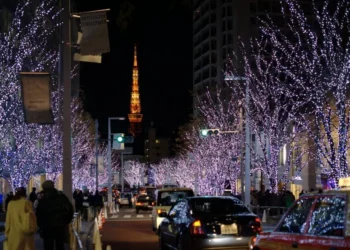No products in the cart.
Exploring the Unique Evolution of Japan’s Porn Industry
Introduction
Japan’s porn industry stands out as one of the most significant and distinctive globally. To understand why, it’s essential to delve into Japan’s cultural history and the social factors that have shaped this industry. Despite Japan’s reputation for being conservative, the adult entertainment industry has deep roots in the country’s traditions, and its growth over the years offers insight into Japan’s unique relationship with sexuality and media.
The Historical Background: From Shunga to Contemporary Adult Content
Japan’s fascination with erotic art has ancient origins. One of the earliest examples is “shunga”, a type of erotic woodblock printing that gained popularity during the Edo period (1603–1868). These prints were explicit in nature, depicting a wide range of sexual acts and fantasies. Unlike the Western world, where such material might have been taboo, “shunga” was widely accepted in Japanese society, appealing to both men and women. It was seen not just as art, but also as a form of entertainment, and many famous artists, including Hokusai, contributed to this genre.
The widespread acceptance of “shunga” was tied to the cultural context of the Edo period. This era was marked by a strict social order and a set of rigid societal rules, which led to the development of pleasure districts—areas where people could escape the constraints of daily life to indulge in various forms of entertainment, including erotic art. “Shunga” prints were an extension of this culture, offering an accepted way to explore sexual fantasies.

Shifts in Adult Entertainment: Modernization and the Birth of Pornography
With the advent of the Meiji period (1868–1912), Japan began to modernize rapidly, absorbing Western technologies and cultural practices. This included the adoption of photography and film, which quickly became new mediums for producing erotic content. Throughout the early 20th century, adult magazines and films began to surface, although they often faced censorship or were outright banned by authorities. This period reflects the ongoing tension between Japan’s traditional values and the influence of modern, Western ideas.
The post-World War II era brought significant social and economic changes to Japan. The American occupation introduced new perspectives on freedom of expression, and Japan’s economic boom in the following decades created a demand for diverse entertainment forms. The 1960s and 1970s saw the emergence of “pink films”, low-budget movies with softcore pornographic content that were shown in theaters. These films began to push the boundaries of acceptability, paving the way for the more explicit content that would define the modern porn industry.
The Modern Era: Rise of the AV Industry
The introduction of VHS technology in the 1980s was a game-changer for Japan’s porn industry. It made adult content more accessible by allowing people to watch it privately in their homes. This led to the emergence of “AV” (adult video) idols—actors and actresses who became famous for their roles in pornographic films. These idols gained a level of celebrity status, complete with fan clubs and media appearances. The AV industry became highly organized, with production companies, talent agencies, and distribution networks that mirrored those of mainstream entertainment.
Several factors contributed to the growth of the porn industry during this time. Japan’s advanced technology and infrastructure made production and distribution efficient, while the country’s large population and economic prosperity ensured a substantial market. Additionally, Japan’s cultural acceptance of erotic content, rooted in traditions like “shunga”, reduced the stigma associated with consuming or producing porn.
Cultural Dynamics: Social Attitudes and Consumption
Understanding why Japan’s porn industry is so significant requires examining the broader cultural and social environment. In Japanese society, there is a strong distinction between public and private life. People are expected to adhere to strict social norms publicly, but in private, they have more freedom to explore personal desires. This separation creates a demand for products and services that cater to private fantasies.
The Japanese concepts of “honne” (true feelings) and “tatemae” (public facade) are particularly relevant. There is often a disconnect between what people truly feel and how they behave in public. Japan’s porn industry caters to these hidden desires, offering a socially acceptable outlet for what might otherwise remain repressed.
Another factor is Japan’s low birth rate and shifting attitudes toward relationships. Many young people are delaying marriage or choosing to remain single, leading to a decline in traditional family structures. This has fueled the demand for alternative forms of intimacy, with pornography serving as one outlet for sexual expression without the complexities of real-life relationships.

Legal Environment and Regulatory Landscape
Japan’s legal framework has also played a significant role in the development of its porn industry. While the production and distribution of pornographic content are permitted, they are subject to strict regulations. For instance, explicit depictions of genitalia are censored, typically through the use of mosaics or blurring. This form of censorship is rooted in Japanese law, which prohibits the display of “obscene” materials, though the interpretation of what constitutes obscenity has evolved over time. The industry has adapted to these regulations, leading to the creation of a wide variety of adult content that pushes the boundaries within legal constraints.
Technology’s Impact on the Industry
Japan’s technological advancements have been instrumental in the growth of the porn industry. The country was quick to embrace digital media, and the internet revolutionized how adult content was produced and consumed. Online platforms, streaming services, and digital downloads made it easier than ever for consumers to access pornographic content. This technological shift also allowed producers to reach a global audience, expanding the industry’s reach beyond Japan’s borders.
In recent years, new technologies like virtual reality (VR) and artificial intelligence (AI) have started to shape the industry. VR offers immersive experiences, while AI is being used to create realistic digital avatars and interactive content, keeping Japan’s porn industry at the cutting edge of global trends.
Conclusion
Japan’s porn industry has grown into a massive and distinctive part of the country’s economy and culture due to a combination of historical, cultural, and technological factors. From the erotic art of the Edo period to the rise of AV idols and the latest digital innovations, Japan has developed a complex relationship with erotic entertainment. This industry reflects the country’s unique blend of tradition and modernity, providing insight into how Japan balances public propriety with private desire. While Japan is often seen as a conservative society, its thriving porn industry shows a more nuanced reality, where cultural norms and personal freedoms coexist in a dynamic and evolving landscape.










